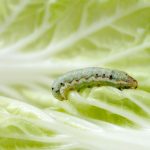Are You Seeing Tiny Black Bugs on Plants Outside? Then Read This
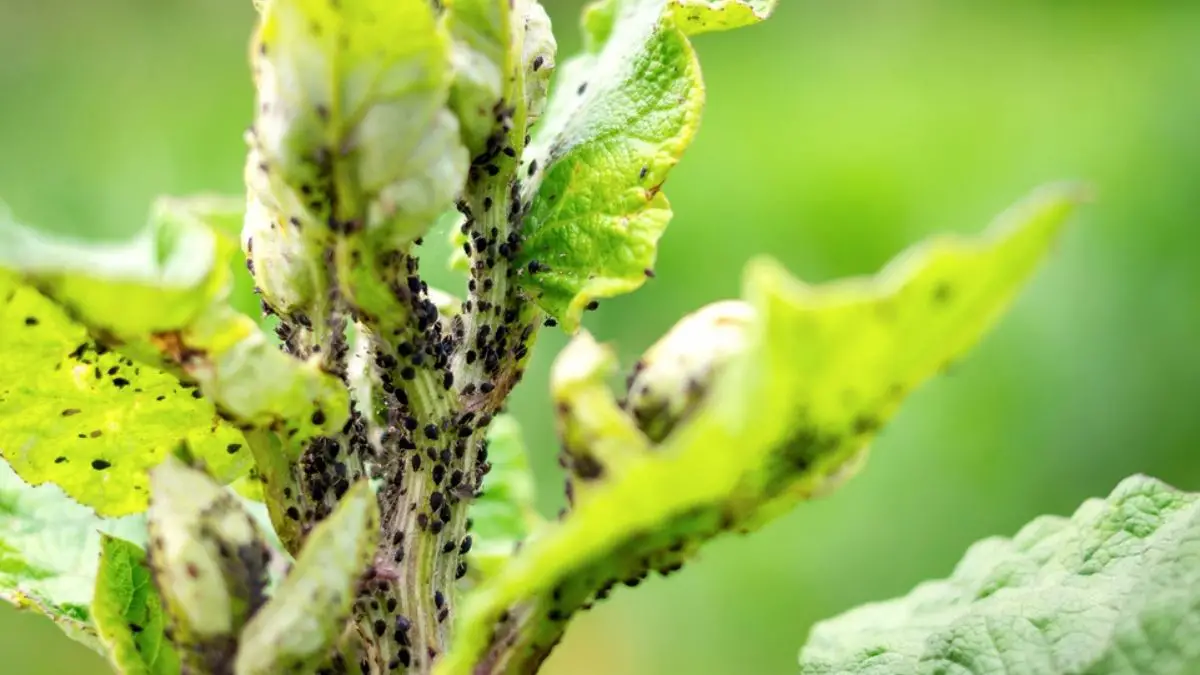
Are you seeing tiny black bugs on plants outside lately? Wondering what these might be? Don’t worry we have got you covered. For growers, Bugs are the most annoying creatures. They harm leaves, stems, and fruits which can even lead to the death of plants. Hence, All the efforts a grower put to grow a top-quality plant go in vain. So, it becomes necessary to keep an eye on them.
But what to do when you detect small black bugs on outdoor plants? Yes, you start the treatment to get rid of them immediately. In this article, we have described the top proven treatments to protect your plants from these bugs.
Let’s start the article by knowing who are these bugs that you see on your plants.
What are the Tiny black bugs on plants outside?
People frequently search what are tiny black bugs on my plants and we know the answer. Mostly, four bugs harm the plants. Let’s have a look at them one by one.
Black Aphids
Aphid is a tiny, soft-bodied, and pear-shaped sucking insect that is commonly found in clusters. These tiny black bugs look like poppy seeds.
Where to look to spot aphids? Well, these are commonly found on the underside of the leaves. A small population of these insects does not harm the plants but if the population gets dense, then your crop will experience heavy damage. These black bugs suck cell sap which causes leaves to wilt and die. This leads to a low photosynthesis rate, hence, stunted growth and poor overall quality.
| Aphid | Size | Shape & Color |
| Adult | 1/16 to 1/8 inch long | Pear-shaped and has a wide range of colors. |
| Nymphs | 1.5 to 2.26mm long | Pear shade and are of black, white, and red. |
They are in a wide range of colors. But the tiny black bugs on plants outside in the field or garden you see are black bean aphids and black fly aphids.
The biggest problem to curb their population is that these bugs reproduce quickly. After hatching, the young ones quickly reach maturity and give birth to new eggs. So, if you see only a small number of these bugs and ignore them, then this could prove to be the biggest mistake as they reproduce at an unbelievable rate.

Aphids can be both winged or wingless. Nymphs (young ones are wingless) and if the over-crowding of the insects happens, winged aphids are also seen. Winged aphids are sometimes mistaken for gnats. So, examine carefully.
MealyBugs
Mealybugs are wingless, soft-bodied sucking insects that feed on stems, leaves, and fruits. They appear as white cottony mass from a distance. At first, they look like fungus or molds. But when looked closely, you can see these insects.
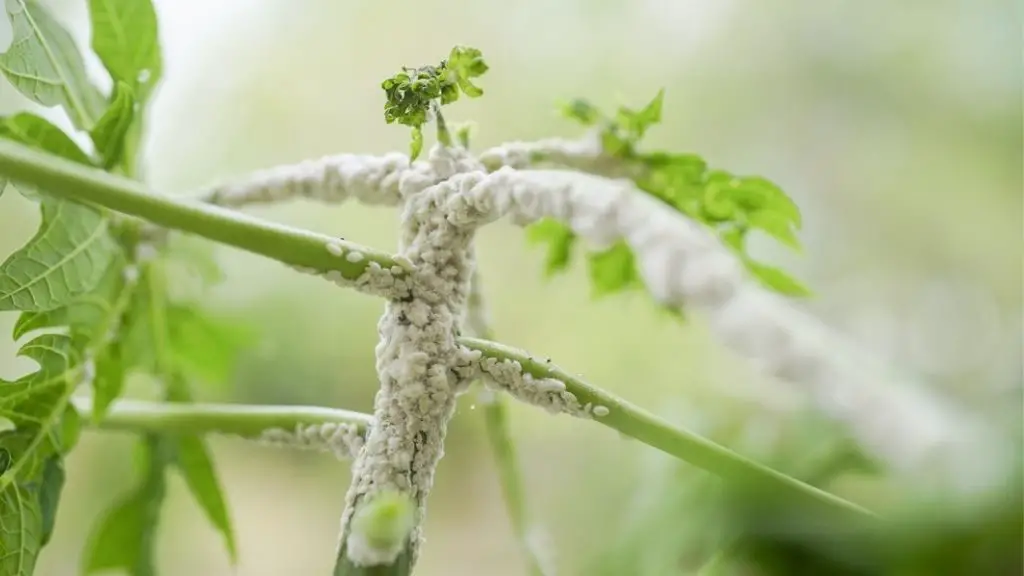
So, if you see tiny black bugs on plant stems, chances are these must be mealybugs. So, how do they damage your plants? Well, first, these insects insert their mouthparts in the plant tissues. With the help of these mouthparts, they start sucking the sap from the foliage. If this happens for a long time, sooty molds can also occur which affects Photosynthesis.
| MealyBug | Size | Shape & Color |
| Adults | 1/10 to 1/4 inch long. | Oval in shape and white. |
| Larvae | 1/20 to 1/5 inch | Oval in shape and color is Light yellow |
Mealybug eggs are always appearing in hundreds. After laying, female adults die soon. After 1-3 weeks, hatching occurs. As the mealybug larvae feed the foliage, they secret a honeydew which forms wax on their body.
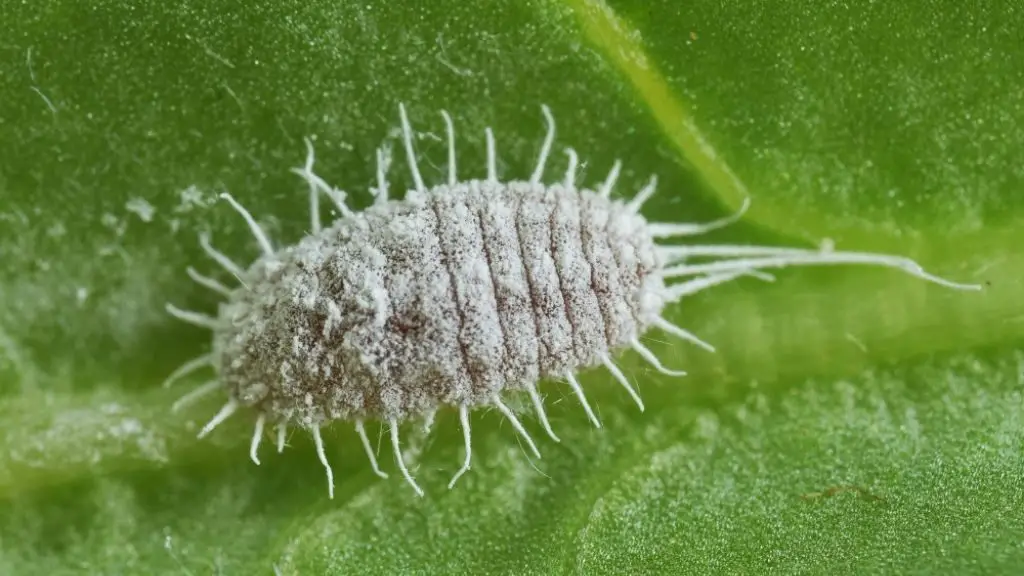
If not controlled, these can cause stunted growth and fewer leaves on plants. Their attack weakens the plant which can also kill it. So, be extra careful if you observe them.
Spider Mites
The spider mite is a tiny sucking pest that is present on the underside of the leaves where they do webbing. People generally think of them as insects but Spider mites are not insects. They are Arachnids and belong to Acari (mite) family. But you should not take these black household bugs lightly. They have the potential to cause havoc in indoor plants and outside gardens.
| Spider Mites | Size | Shape & Color |
| Adults | 1/50 inch in size | Oval Shaped and reddish-brown or pale in color. |
| Nymphs | 1/70 inch | Oval shaped and pale in color |
Females can give birth to even 300 eggs after mating. Also, to your surprise, after hatching, these mites can turn into adults in five days only. Due to this, it becomes necessary to get rid of these tiny black bugs on plants inside by using strips.
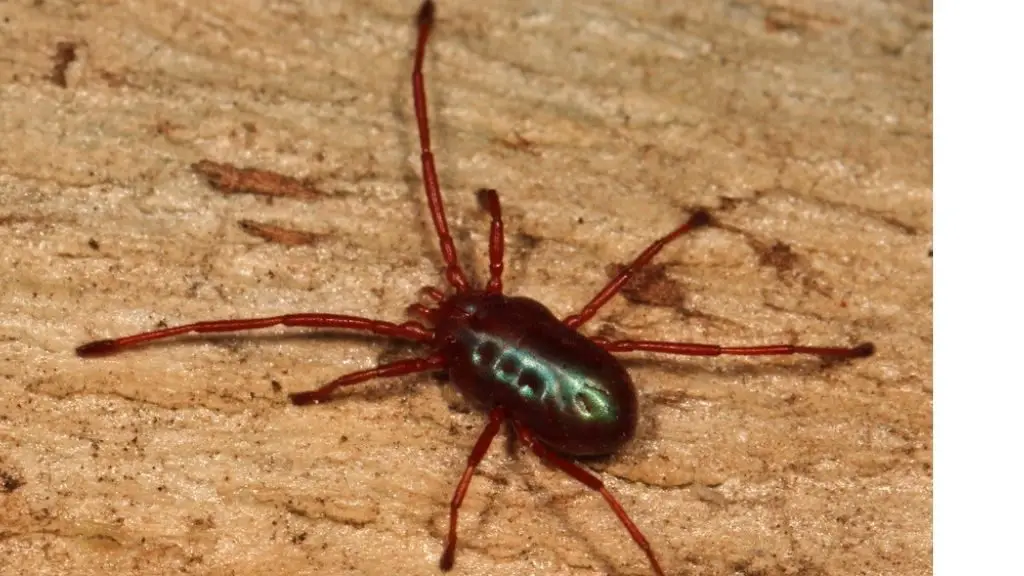
They are common in areas with warmer climates. It is almost impossible to see a single mite. You can only observe this mite bug if the population exceeds in number and they start making a web. Then on these webs, you can clearly see mites.
So, how do they damage plants? They suck the cell sap which causes yellow spots to appear on leaves. If the infestation continues, then leaves get weakened and then die. Neither outdoor nor indoor plants are safe from them.
Fungus Gnats
These are also termed as “Most common house bugs.” Most of the time when you see Tiny black bugs on plants outside, these are fungus gnats.
| Fungus Gnats | Size | Shape & Color |
| Adult | 1/16 to 1/8 inch long | Flies like shape and greyish or blackish in color |
| Larvae | 1/4 inch | Legless and White in color. |
If you look at your outdoor or even indoor plant and see some flies flying around in clusters, then these are Gnats. To further confirm this, shake the plant, then a swarm of the gnats will come out from the soil. They are also known as Soil Gnats and houseplant pests in the soil.
So, what type of damage do these flies cause? Adult black fungus gnats lay their eggs in the soil. After three days, eggs are hatched. The larvae of these houseplant bugs have a shiny black head with a transparent body. The larvae start feeding on the dead organic matter and plants’ thin roots. Due to this, your houseplant will appear as if it has any root disease like root rot. Fungus gnat pupa does not harm the plant.
Due to these houseplant bugs, lower leaves will first turn yellow, and then plant growth will be stopped. If the situation gets out of control, then your houseplant can even die as well.
Moreover, fungus gnats in the soil can also cause Pythium pathogen spread. In this, leaves damping-off occur.
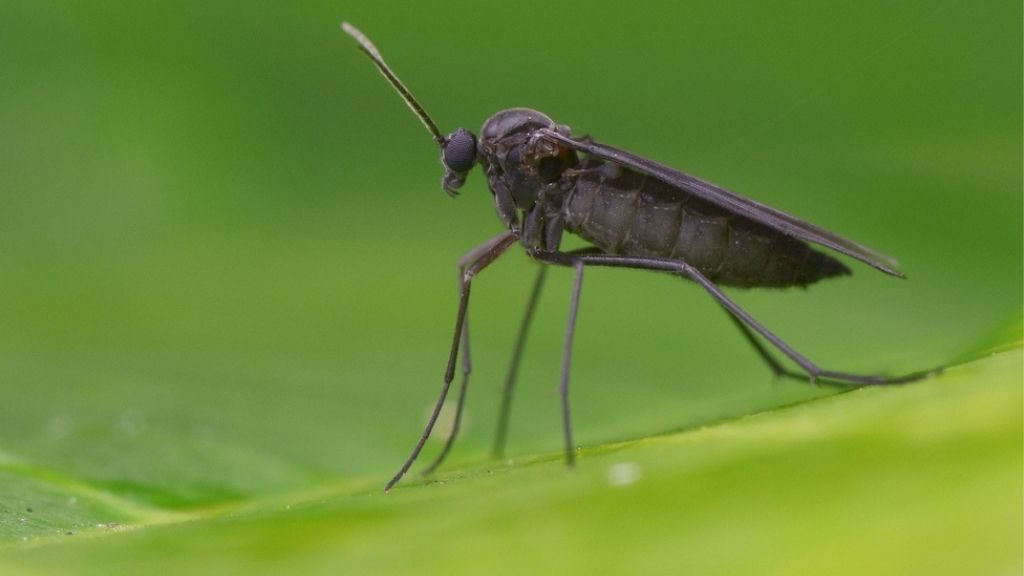
- Gnats are not harmful to humans as they don’t bite or act as a vector of any disease like mosquitoes. Same goes with every other bug we have described. So, don’t fear for your health if you see tiny black bugs on plants outside.
Flea Beetles
Flea beetles are small chewing insects that mostly impact vegetable and flower crops. They cause heavy damage at the seedling stage of the plant.
| Flea Beetle | Size | Shape & Color | |
| Adult | 1/16 to 1/8 inch long | The shape is just like other beetles but legs are larger & color is Black | |
| Larvae | 1/10 inch | Wom like and color is Pale |
Flea Beetles are damaged by chewing leaves and stems. Due to their chewing, little holes are also formed which is also a sign of their infestation. Whenever you start seeing tiny holes in the leaves, then look for these beetles and start the treatment.
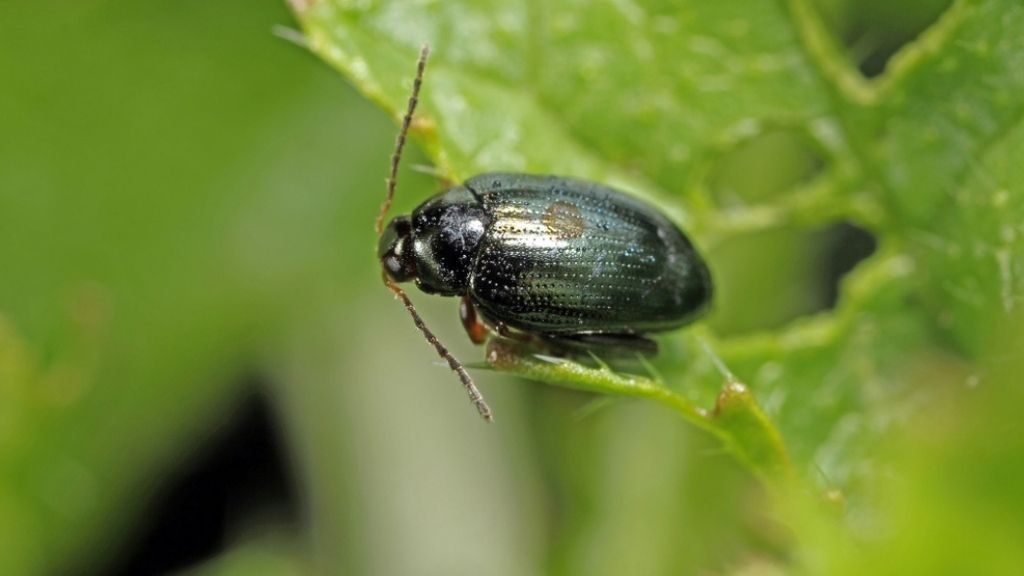
- Carpet beetles, and clover mites can also be found on your indoor plants.
Now, it is time for the most important part of the Article. How to get rid of little black bugs on outdoor plants (works on indoor plants too).
How to Get Rid of Tiny Black Bugs on Outdoor Plants?
If you see Tiny black bugs on plants outside, then immediately start thinking about the treatment. Both Biological and chemical control is adopted to get the bugs population in control. However, biological control is preferred over chemical control as it is cheap and eco-friendly.
In chemical spraying, chemical residues can be left on the plants which can deteriorate the quality. But chemical control is fast and effective than biological controls. You can get rid of insects within minutes after chemical spraying. So, which control you want depends upon your choice.
Below are some measures you can take to control bug infestation.
Biological control
Check out some of the natural measures a grower can take:
Neem Oil
Do you know you can use neem oil for fleas and for aphids control? Neem oil is an extract from neem trees that is widely used as an insect repellent. It is yellowish in color and tastes and smells bitter. Also, you can kill fungus gnats organically with the help of neem oil application.
Black bugs like aphids repel a strong smell. But that’s not it! When neem oil falls on the exoskeleton of insects, it stops their breathing. Then due to suffocation, insects die.
Also, neem oil can stop insects from laying eggs, maturing, and even mating. Also, Neem oil is preferred by growers because it is not harmful to humans and animals.
Watering for pest control
To your surprise, You can also use water to get rid of insects. But how? Well, This method is widely used in Aphid infestation. All you have to do is directly shower water on these insects to get rid of them. These insects will fall off from the plants and due to the laziness in their nature, it gets harder for them to climb again. Moreover, you can use other methods like overwatering the pots or soil as well so that these harmful insects can die there drowning.
Also, you can use this water spray to get rid of the webbing of mites. This affects the rate of their damage.
Release of Beneficial insects
This is not a common control measure but still, it is effective and eco-friendly. In this, you release beneficial insects which kills the harmful ones. Following are the beneficial insects:
- Ladybird beetles
- Lacewings
- Praying mantis
- Hoverflies, etc.
They start killing and eating harmful insects which control their population. Do you know that the favorite food ladybird likes to eat is Aphid? Well, yes ladybird loves feasting on aphids.
Moreover, Green lacewings larvae also don’t spare any aphids. The most ferocious among the above beneficial insect is the praying mantis. This insect is like a final boss you face at the end of the video game. It preys on a wide range of insects including flies, carpet beetles, moths, etc. Similarly, hoverfly larvae feed on many insects including Aphids.
Chemical Spray (Insecticide)
The chemical spray is the quickest method of Pest control. There is a wide range of insecticides available in the market. Almost every insecticide contains Dichlorvos (DDVP) which directly affects the nervous system of insects. Since the central nervous system is directly affected, insects die shortly. Other chemicals used in an insecticide are Hydrogen Cyanide, naphthalene, nicotine, and methyl bromide.
There is one disadvantage of using chemical sprays which is pollution. The chemical fumigants can cause air pollution and the chemical residues that fall on the soil can ward off towards the local streams or leach down to groundwater.
Moreover, the residues of chemicals can be left on the leaves which can cause further complications. If humans or animals eat such leaves, then it causes health problems.
Hydrogen Peroxide spray
There are three forms of Hydrogen Peroxide available in the market- 3%, 6%, and 35% you can use for pest control. Mostly, 6% Hydrogen Peroxide is used. It is mixed in the water. Then this mixture is added to the soil just like you water plants. Fizzing will appear which will kill every larva that comes in contact with it.
Moreover, you can also apply the hydrogen peroxide solution as a spray. Spray the solution directly on leaves or root areas for better results.
Insecticidal Soaps
You can also use insecticidal soaps to get rid of tiny black bugs on plants outside your home. In this, you use potassium salts of fatty acids as an ingredient. This soap is highly effective against soft-bodied bugs.
Some Preventions to stop the Houseplant Bugs infestation
The proverb,” Prevention is better than cure” is true in the sense that you don’t have to spend time and money on treatment if you just focus on prevention which is rather easy. Below are some preventions to stop houseplant bugs infestation:
Avoid Over-fertilization
Avoid adding too much Nitrogen fertilizers as this leads to plants appearing lush green. This lush green color attracts both chewing and sucking insects. This is why you see more insects on the lush green plants with better vegetative growth than others.
Keep the Environment clean
Make sure everything around your plant is clean for pest control. Dust on leaves or stems attracts spider mites. Also, while using gardening tools, disinfect them first a these may have eggs of insects on them.
Moreover, don’t let the weeds grow in your field or gardens. Weeds are the host of many bugs and their presence can lead to heavy infestation. So, uproot them or use a herbicide whenever you spot weeds.
Use insect resistant varieties
Modern agriculture was introduced after the invention of machinery and the production of new varieties. In the last few decades, hundreds of varieties have been developed that are insect resistant as well. Bt varieties are the common one that has shown tremendous resistance against insect attack. So, use such varieties to protect the plants from any kind of bugs.
Final Words
All-inclusive, growers worry about Tiny black bugs on plants outside (in a garden or a field). Generally, these tiny bugs are aphids, mealybugs, spider mites, flea beetles, and gnats. All of them can cause heavy damage and can even lead to the death of plants. That is why their infestation must be controlled. Keep observing your plants (especially the underside of the leaves) to get an idea about any pest infestation. If you see them, then immediately start the treatments we have described in this article. Don’t even take a small number of insects lightly!
FAQs About Tiny Black Bugs on Plants Outside
What are the tiny black bugs on my plants?
The tiny black bugs on the plants outside are Aphids, mites, soil gnats, and mealy bugs. Some fleas can also be found too.
How do you kill bugs without killing plants?
People ask, how to get rid of tiny black bugs on plants. Well, You can kill bugs without harming plants by choosing the following treatments:
- Use of Beneficial insects
- Use of Neem Oil
- Spraying water directly on insects
- Use of Hydrogen Peroxide solution
All of these methods do not harm the plants but are very effective in getting rid of insects
What to spray on plants to kill bugs?
You can spray the following things on plants to get rid of insects:
- Hydrogen Peroxide
- Chemical Sprays containing Dichlorvos
- Neem oil
- Water
Related Topics:


